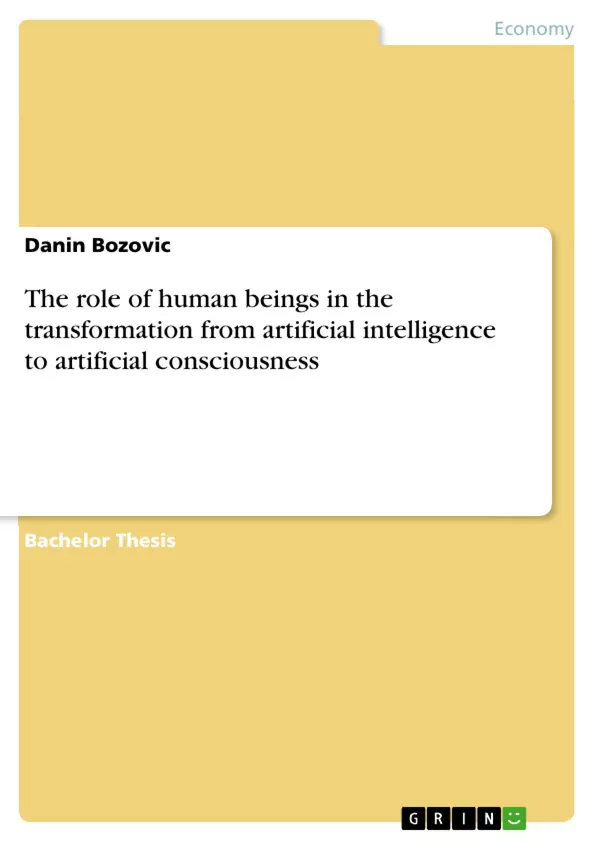The purpose of this thesis is to discover in what way human beings will experience a transformation of their own position as creators in the world of tomorrow. Digital transformation, the era of life 3.0, automation, Internet of Things, Big Data and Artificial Intelligence are major frontier technologies, that today’s business world is confronted with. The idea of obtaining the highest possible amount of efficiency in our society and meanwhile reaching the greatest point of human capacity, through widening our own horizon and creating inorganic mechanisms, that know and continue to learn how to function on a level of an organic life are the most recent and thought provoking aspects of our current time.
This manner of research is significant, because humankind is only at the beginning of incorporating inorganic life into their work sphere, which leads many corporations to creating trend hubs, hiring the best available technology experts to consult the company and prepare it for future incidents. The conversation covers predominantly the technology itself, but not what will happen to the person being replaced, which is a decisive element in people refusing opportunities. They are not aware of what will happen to them and how their role changes.
Inhaltsverzeichnis (Table of Contents)
- Introduction
- Artificial Intelligence
- What is intelligence?
- What is memory?
- How do we learn?
- Can machines think? Turing Test
- The Winograd Challenge exuberates the thinking of machines...
- Comparison of artificial intelligence and biological intelligence
- Current State of Artificial Intelligence
- Artificial General Intelligence
- Society's perception of artificial intelligence
- Ethical problems of artificial intelligence
- What is intelligence?
- Consciousness
- What is consciousness? An exposition of the philosophic debate through the course of time
- What is consciousness? A scientific approach to the revelation of the mystery
- The importance of the intersection of philosophy and science in today's time.
- Does artificial consciousness exist?
- What importance does artificial consciousness have?
- Future work
- Definition of the term.
- The role of human beings in the prospective work sphere.
- Productivity augmentation due to the introduction of machines and computers
- Why can we augment productivity?
- Company example of how humans and machines work together
- Future work under the consideration of business ethics
Zielsetzung und Themenschwerpunkte (Objectives and Key Themes)
This bachelor thesis aims to explore the transformative impact of artificial intelligence (AI) and artificial consciousness on the role of human beings as creators in the future. The work examines the implications of these technologies for productivity, business ethics, and the changing nature of work.
- The definition and nature of intelligence, both human and artificial
- The development and current state of artificial intelligence
- The concept of consciousness and the possibility of artificial consciousness
- The ethical considerations surrounding artificial intelligence and its impact on society
- The role of human beings in the future workplace with the integration of AI and automation
Zusammenfassung der Kapitel (Chapter Summaries)
- Introduction: This chapter introduces the thesis's core objective: to investigate the impact of AI and artificial consciousness on the role of human beings as creators in the future. The chapter highlights the significance of these technologies in today's world and sets the stage for the subsequent exploration of their implications.
- Artificial Intelligence: This chapter delves into the concept of artificial intelligence (AI), examining its definition, characteristics, and limitations. It discusses the Turing Test and the Winograd Challenge as measures of machine intelligence, comparing AI with biological intelligence. The chapter also explores the current state of AI, including Artificial General Intelligence and the ethical considerations surrounding its development.
- Consciousness: This chapter explores the multifaceted concept of consciousness, examining its philosophical and scientific definitions. It delves into the historical debate surrounding consciousness and highlights the importance of integrating philosophical and scientific perspectives on this complex phenomenon. The chapter also investigates the question of whether artificial consciousness exists and examines its potential implications.
- Future Work: This chapter focuses on the future implications of AI and artificial consciousness for the workplace. It examines the role of humans in a future dominated by automation and discusses the concept of productivity augmentation through the integration of machines and computers. The chapter also considers the ethical implications of these developments in the context of business ethics.
Schlüsselwörter (Keywords)
This thesis explores the intersection of artificial intelligence, artificial consciousness, human creativity, productivity, and the future of work. Key themes include the development and capabilities of AI, the philosophical and scientific debate surrounding consciousness, the ethical implications of these technologies, and the evolving role of humans in a rapidly changing world.
- Quote paper
- Danin Bozovic (Author), 2020, The role of human beings in the transformation from artificial intelligence to artificial consciousness, Munich, GRIN Verlag, https://www.grin.com/document/989945



